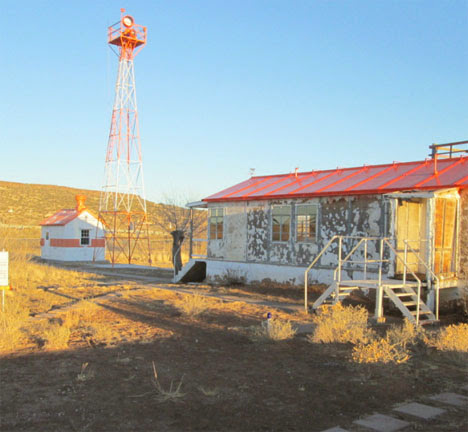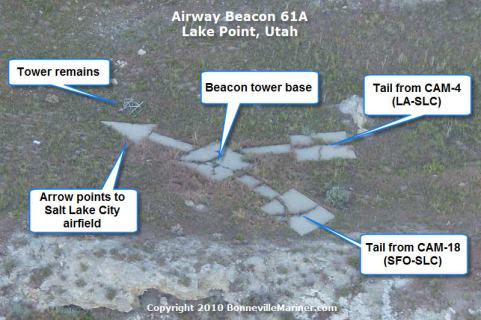arrow spotting!
nothing so consprital, they are in fact a guide for airmail pilots when flights would otherwise be grounded due to inability to properly navigate, the system used fifty-foot beacon towers with rotating lights placed on top of concrete foundations shaped like arrows, usually between 50-70 feet in length a small hut offered a place to stay for the people who maintained the generators and lights,
by the end of the first year of the program, the airmail service had 18 terminal airfields and more than 500 beacon lights in operation along the main mail delivery route, and continued to expand throughout the 1920s, but by 1933, new technology and the high cost of operation during the depression shut the program down,
a few have been preserved, like the one pictured above at the Western New Mexico Aviation Heritage Museum, so the mission is take a picture of each one left and to make things easier here is a list of some of the ones that are known about,
• A concrete arrow is all that is left of Beacon 68 just west of Albuquerque, New Mexico.
• The faint outline of a concrete arrow and generator shack is still visible in Battle Mountain, Nevada (beacon number unknown).
• A concrete arrow just off Interstate 80 about 25 miles southeast of Boise, Idaho points toward the city (beacon number unknown).
• In the wilderness outside of Cheyenne, Wyoming, the remote concrete arrow of Beacon 38 sits undisturbed.
• The faint remains of a concrete arrow can be seen in the defunct municipal airfield in Columbus, New Mexico (beacon number unknown).
• The concrete arrow of Beacon 33 is still visible inCottage Grove, Minnesota. It is even visible in street view!
• The concrete arrow and generator shed atDelaware Springs Intermediate Field are still visible, deep in remote Texas. Read more about Delaware Springs Field here.
• About 20 miles northeast of Ellensburg, WA, the foundation remains of a beacon can still be seen(beacon number unknown).
• Just outside of Fernley, Nevada sits a lone beacon tower missing the concrete arrow and generator shed (beacon number unknown).
• A concrete arrow is visible off Old Highway 40 near Golconda, Nevada (beacon number unknown).
• The generator shed is all that’s left of Beacon 61 in the mountains of Grants, New Mexico. The tower and concrete arrow may be gone, but you can still see “61″ on the roof of the shed.
• The concrete arrow of Beacon 59 sits right off US-80 in Grantsville, Utah, southwest of the Great Salt Lake.
• About 55 miles east of El Paso in the middle of nowhere, Texas, the concrete arrow ofHudspeth Intermediate Field barely pokes out of the brush (pictured above). Hudspethwas constructed in the 1930s by the Department of Commerce for emergency use by airlines, but hasn’t been used in half a century.
• The concrete arrow with twin tails from Beacon 61A can be seen just off the Lincoln Highway in Lake Point, Utah. (pictured below, courtesy BonnevilleMariner.com)
• Faint remnants of a concrete arrow in Locomotive Springs, Utah (beacon number unknown).
• In Lovelock, Nevada, another concrete arrow can be seen (beacon number unknown).
• Here’s a concrete arrow off a dirt road in Meacham, Oregon (beacon number unknown).
• The Aviation Heritage Museum of Milan, NM has Beacon 62 (originally located in Bonita Canyon) restored to its original 1930s appearance, complete with painted tower and corresponding generator shack
• Up on Beacon Hill Road in the Moapa Valley region of Nevada, a concrete arrow is still visible (beacon number unknown).
• The concrete arrow of the former MX1095 Beacon can be seen just east of the airport inMontague, California.
• Here is a right-angle concrete arrow from Beacon 50 visible in Montello, Nevada.
• The concrete arrow from Salt Flat Intermediate Field is barely visible in lonely Salt Flat, Texas. This emergency landing field was another product of the Department of Commerce in the 1930s. This page has more detail on the now-defunct Salt Flat Intermediate Field.
• Two miles northwest of Seama, New Mexico, the concrete arrow of Beacon 64 sits behind Flower Mountain, not far from Interstate 40.
• A concrete arrow sits in good condition at Shelbyville Municipal Airport about 25 miles southeast of Indianapolis in Indiana (beacon number unknown).
• Another concrete arrow – this one from Beacon 37B – can be seen on the south edge of theShinob Kibe Mesa in Utah.
• The concrete arrow from Beacon 37A is visible from the Bloomington Overlook location in St. George, Utah.
• A concrete arrow is all that’s left of Beacon 37Cat the Quail Creek Reservoir in Utah between Hurricane and St. George.
• The concrete arrow by Strevell Road near the Idaho/Utah border is clearly visible along with the foundations of other facilities, now gone (beacon number unknown).
• Beacon 14A is still overlooking US-80 in theTahoe National Forest in California. The concrete arrow is gone, but the tower remains. A newer building has replaced the generator shed next to the tower.
• Just outside the Toiyabe National Forest in Reno, a concrete arrow is barely visible and in poor condition (beacon number unknown).
• Little other than the tower’s foundation of Beacon 5 is still visible in Vacaville, California.
* A two-arrow, two-tail beacon is vandalized, but visible in Walnut Creek, California.(courtesy S-I reader Bob Simmons, beacon number unknown)
• The well-preserved tower of airway Beacon 32 is still in use at Winnemucca Municipal Airport in northern Nevada. You can even see this pristine example in street view. (No concrete arrow or generator shed)
• In Woods Cross, Utah, there is a concrete arrow northeast of the Salt Lake City Airport(beacon number unknown).*
Air Traveler’s Map, 1929
“Illustrated Map of the Route of Transcontinental Air Transport,” Rand McNally, 1929. Courtesy David Rumsey Map Collection.
Click thumbnail to view full-size (warning: large file)
*
For a more robust map of reported beacon locations, this user-created Google map has quite a few in the west. This Google document also has assimilated numerous beacon locations nationwide. A listing of beacons can be seen here, although not all have been “found.”
but how many are there out there? I doubt if any one really knows.






No comments:
Post a Comment